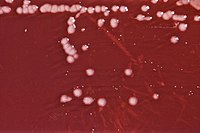
Photo from wikipedia
Most of the clinical isolates, identified as P. putida or P. fluorescens, were misidentified in clinical laboratories. Whole-genome sequencing (WGS) revealed that these isolates belonged to different Pseudomonas species, including… Click to show full abstract
Most of the clinical isolates, identified as P. putida or P. fluorescens, were misidentified in clinical laboratories. Whole-genome sequencing (WGS) revealed that these isolates belonged to different Pseudomonas species, including novel species. WGS is a gold-standard method to identify Pseudomonas species, and MALDI-TOF MS analysis has the potential to complement WGS to reliably identify them. ABSTRACT The genus Pseudomonas, a complex Gram-negative genus, includes species isolated from various environments, plants, animals, and humans. We compared whole-genome sequencing (WGS) with clinical bacteriological methods and evaluated matrix-assisted laser desorption ionization-time of flight mass spectrometry (MALDI-TOF MS) to identify Pseudomonas species. Clinical isolates (N = 42) identified as P. putida or P. fluorescens by a bacterial identification system based on biochemical properties were reexamined by another identification system based on biochemical properties, two systems based on MALDI-TOF MS, and WGS. WGS revealed that 30 of the 42 isolates belonged to one of 14 known Pseudomonas species, respectively. The remaining 12 belonged to one of 9 proposed novel Pseudomonas species, respectively. MALDI-TOF MS analysis showed that the 9 novel species had unique major peaks. These results suggest that WGS is the optimal method to identify Pseudomonas species and that MALDI-TOF MS may complement WGS in identification. Based on their morphologic, physiologic, and biochemical properties, we propose nine novel Pseudomonas species. IMPORTANCE Most of the clinical isolates, identified as P. putida or P. fluorescens, were misidentified in clinical laboratories. Whole-genome sequencing (WGS) revealed that these isolates belonged to different Pseudomonas species, including novel species. WGS is a gold-standard method to identify Pseudomonas species, and MALDI-TOF MS analysis has the potential to complement WGS to reliably identify them.
Journal Title: Microbiology Spectrum
Year Published: 2022
Link to full text (if available)
Share on Social Media: Sign Up to like & get
recommendations!